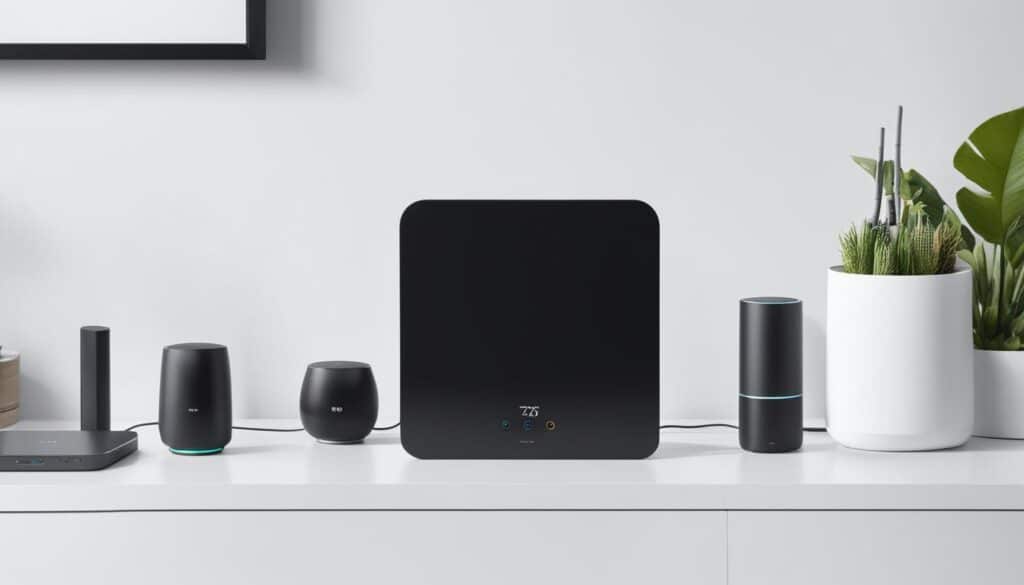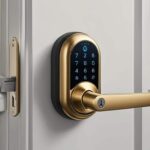In this beginner’s guide, I will help you navigate the exciting world of smart home networking. Whether you’re a tech enthusiast looking to enhance your living space or a curious homeowner interested in the convenience and efficiency of smart devices, this guide is for you. Let’s explore the basics of smart home networking and get you started on your journey to a more connected and automated home.
Table of Contents
Key Takeaways:
- Understanding smart home networking is essential for beginners.
- Connecting devices and establishing a strong Wi-Fi network are fundamental steps.
- Choosing the right smart home hub can simplify device control and automation.
- Setting up your smart home network requires following step-by-step instructions.
- Smart home automation allows you to control devices with ease and create personalized routines.
Types of Smart Home Devices
When it comes to building a smart home network, understanding the different types of devices available is crucial. As a beginner, it’s important to know which devices are suitable for your needs and can enhance your daily life.
Let’s explore some of the most popular types of smart home devices:
- Smart Speakers: These voice-controlled assistants, such as Amazon Echo and Google Home, can play music, answer questions, control other smart devices, and more. They are a great starting point for beginners as they provide a central hub for controlling your smart home.
- Thermostats: Smart thermostats, like the Nest Learning Thermostat, enable you to remotely control your home’s temperature. They can learn your preferences, save energy, and offer convenient features like scheduling and geofencing.
- Doorbell Cameras: With doorbell cameras like Ring Video Doorbell, you can see who’s at your door from your smartphone. These devices provide enhanced security by allowing you to monitor your front door, receive motion alerts, and even communicate with visitors.
- Smart Locks: Smart locks, such as the August Smart Lock, offer keyless entry to your home. You can control and monitor access from anywhere, grant temporary access to guests, and receive notifications when someone locks or unlocks the door.
- Smart Lights: Smart lighting systems, like Philips Hue, allow you to control your lights remotely, create schedules, and change colors to suit your mood. They offer energy efficiency and can be integrated with voice assistants for hands-free control.
Each type of smart home device comes with its own unique benefits and features. By selecting the right devices for your needs, you can transform your home into a more connected, convenient, and secure space.
Establishing a Strong Wi-Fi Network
A strong and reliable Wi-Fi network is essential for a smooth smart home experience. To ensure that your smart home devices function optimally, it’s crucial to improve your Wi-Fi network. Here are some tips to help you achieve this:
1. Placement of your Router
One of the first steps to improve your Wi-Fi network is to consider the placement of your router. By positioning it in a central location, you can minimize signal interference and improve coverage throughout your home. Avoid placing your router near walls or objects that can obstruct the signal. Additionally, make sure your router is elevated and not placed on the floor. This allows for better Wi-Fi signal propagation.
2. Use Wi-Fi Extenders or Mesh Systems
If you have a large home or experience weak Wi-Fi signals in certain areas, consider using Wi-Fi extenders or mesh systems. These devices help extend your Wi-Fi coverage by amplifying the signal or creating a mesh network with multiple access points. By strategically placing these devices throughout your home, you can eliminate Wi-Fi dead zones and enjoy seamless connectivity.
3. Optimize Network Settings
To further improve your Wi-Fi network, optimize its settings. Access your router’s administration panel and ensure that you are using the latest firmware. Adjust the channel settings to minimize interference from neighboring networks. Consider enabling Quality of Service (QoS) features to prioritize certain devices or applications that require a stable connection. These simple adjustments can significantly enhance the performance of your Wi-Fi network.
“A strong Wi-Fi network is the backbone of a smart home, ensuring that your devices can communicate effectively.”
4. Network Security
Network security is of utmost importance for any smart home network. Protect your Wi-Fi network by setting a strong and unique password. Enable encryption protocols, such as WPA2, to prevent unauthorized access. Regularly update your router’s firmware to patch any security vulnerabilities. By taking these precautions, you can safeguard your smart home devices and your personal information from potential threats.
5. Recommendations for Smart Home Device Security
In addition to securing your Wi-Fi network, it is crucial to follow best practices for securing your smart home devices. Here are some recommendations:
- Change default passwords: Set unique and strong passwords for all your smart home devices to prevent unauthorized access.
- Enable two-factor authentication (2FA): Whenever possible, enable 2FA for your smart home device accounts for an added layer of security.
- Regularly update firmware: Keep your smart home devices updated with the latest firmware to benefit from security patches and fixes.
- Disable unnecessary features: Disable any unused features or services on your smart home devices to minimize potential vulnerabilities.
To summarize, establishing a strong Wi-Fi network is essential for a seamless smart home experience. By following these tips, you can enhance the performance, coverage, and security of your Wi-Fi network, ensuring that your smart home devices operate efficiently.
| Benefits of a Strong Wi-Fi Network: | Tips to Improve Your Wi-Fi Network: |
|---|---|
| 1. Reliable connectivity for all smart home devices | 1. Position your router in a central location |
| 2. Seamless streaming of multimedia content | 2. Use Wi-Fi extenders or mesh systems for better coverage |
| 3. Efficient control and automation of smart devices | 3. Optimize network settings for improved performance |
| 4. Enhanced security for your smart home network | 4. Secure your network and smart home devices |
By implementing these strategies, you can ensure that your Wi-Fi network provides a solid foundation for your smart home, enhancing your overall experience and making your daily life more convenient and efficient.
Choosing a Smart Home Hub
When it comes to creating a seamless smart home experience, choosing the right smart home hub is crucial. A smart home hub serves as the central control system for all your smart devices, allowing you to manage and automate them effortlessly.
But what exactly is a smart home hub? Think of it as the brains behind your smart home network. It connects all your devices and enables them to communicate with each other, giving you complete control over your home automation.
Using a smart home hub offers several benefits. First, it simplifies the control process by allowing you to manage multiple devices through a single interface. With just a few taps on your smartphone or a voice command to your virtual assistant, you can control your lights, adjust the thermostat, and lock your doors simultaneously.
A smart home hub also enhances compatibility between different smart devices from various manufacturers. By acting as a universal translator, it ensures that devices using different communication protocols can work together seamlessly.
As a beginner, you have a wide range of smart home hub options to choose from. Some popular choices include:
- Amazon Echo: Featuring the Alexa voice assistant, the Amazon Echo hub offers excellent compatibility with various smart home devices. Its sleek design and advanced voice recognition make it a popular choice among beginners.
- Google Nest: Powered by the Google Assistant, the Google Nest hub provides a user-friendly interface and seamless integration with other Google services. It offers extensive control options and supports a wide range of smart devices.
- Apple HomeKit: If you’re an Apple user, the Apple HomeKit hub is an excellent choice. It offers tight integration with iOS devices and Siri voice control, making it easy to manage your smart home using your iPhone or iPad.
Ultimately, choosing the right smart home hub depends on your specific needs and preferences. Consider factors such as compatibility with your existing devices, ease of use, and the features that matter most to you.

By selecting the perfect smart home hub, you’ll be well on your way to building a smart home network that works seamlessly for you. In the next section, I’ll guide you through the process of setting up your smart home network, ensuring a smooth and hassle-free experience.
Setting Up Your Smart Home Network
Now that you have your devices and hub, it’s time to set up your smart home network. Connecting your devices to the hub and integrating them into your network may seem overwhelming, but with a step-by-step process, it can be a breeze. Let’s dive in!
Step 1: Device Pairing
The first step is to pair your smart home devices with the hub. Each device may have a different pairing process, so refer to their specific instructions. Typically, this involves putting the device into pairing mode and allowing the hub to detect and connect to it.
Step 2: Adding Devices to the Hub
Once your devices are paired, you’ll need to add them to your smart home hub. This is done through the hub’s companion app or control panel. Follow the instructions provided by your hub’s manufacturer to add each device successfully.
Step 3: Troubleshooting Setup Issues
During the setup process, you may encounter some common issues. Here are a few troubleshooting tips to help you resolve them:
- Ensure that your hub and devices are within range of your Wi-Fi network.
- Check for any firmware updates for your hub and smart home devices.
- Restart your hub and devices to refresh the connection.
- Double-check that you have followed the pairing and setup instructions correctly.
If you are still experiencing issues, consult the troubleshooting guide provided by your hub’s manufacturer or reach out to their customer support for assistance.
Sample Smart Home Network Setup
| Device | Brand | Compatibility |
|---|---|---|
| Smart Speaker | Amazon Echo | Alexa |
| Thermostat | Nest | Google Assistant |
| Doorbell Camera | Ring | Amazon Alexa |
| Smart Lock | August | Apple HomeKit |
Here’s a sample smart home network setup using popular brands and their compatibility with different voice assistants. Keep in mind that compatibility may vary depending on the specific models and versions of the devices you choose.

With your devices successfully connected to your smart home hub and integrated into your network, you are now ready to explore the endless possibilities of a smart home. In the next section, we will delve into smart home automation and control, where you can unleash the full potential of your smart home network.
Smart Home Automation and Control
One of the key benefits of a smart home network is the ability to automate and control your devices. With the advancements in smart home technology, you can effortlessly manage and customize your devices to create a personalized and convenient living experience.
Creating automation routines is a fantastic way to simplify your daily tasks and enhance your home’s efficiency. For example, you can set up an automation routine that turns off lights and appliances when you leave home, helping you save energy and money. Additionally, you can adjust the thermostat based on your schedule, ensuring optimal comfort while minimizing energy wastage.
Controlling your smart home devices can be done through various methods, allowing you to choose the option that best suits your preferences and lifestyle. Here are some popular methods:
Voice Commands
Many smart home devices are compatible with voice assistants such as Amazon Alexa or Google Assistant. By simply speaking commands, you can control your devices hands-free. Whether it’s turning on lights, adjusting the temperature, or playing your favorite music, voice commands offer a convenient way to interact with your smart home.
Smartphone Apps
Most smart home devices come with dedicated smartphone apps that allow you to control them remotely. Whether you’re at home or away, you can use your smartphone to turn on/off lights, monitor security cameras, or manage other devices. These apps often provide advanced features like scheduling, scene customization, and device grouping for effortless control.
Dedicated Control Panels
In addition to voice commands and smartphone apps, you can also opt for dedicated control panels to manage your smart home devices. These panels provide a centralized interface for controlling multiple devices at once. They often have touch screens, allowing you to navigate through various settings and features with ease.
Having the ability to automate and control your smart home devices not only simplifies your daily routines but also enhances your overall living experience. Imagine arriving home to a well-lit, perfectly climate-controlled environment, all managed effortlessly with a voice command or a tap on your smartphone. Smart home automation truly transforms your house into a personalized oasis of comfort and convenience.
By exploring the world of smart home automation and control, you can unleash the full potential of your devices and create a connected living space tailored to your needs. From scheduling routines to adjusting settings, the power is in your hands to create a smart home that caters to your lifestyle.
Conclusion
Now that you have gained a solid understanding of smart home networking, you are well-prepared to embark on your journey into the world of smart home technology. Throughout this guide, we have covered the essential topics of connecting devices, establishing a strong Wi-Fi network, choosing a smart home hub, setting up your network, and automating your devices. Armed with this knowledge, you can confidently create a seamless and enjoyable smart home experience.
As you begin to build your smart home network, remember to prioritize security. Regularly update your devices’ firmware and change default passwords to protect against potential vulnerabilities. Additionally, consider implementing network security measures like firewalls and encryption protocols to safeguard your smart home network from external threats.
Whether you’re controlling your devices with voice commands, smartphone apps, or dedicated control panels, enjoy the convenience and efficiency that smart home technology brings to your daily life. Experiment with automation routines to simplify your routines and enhance your comfort. With a robust and secure network, your smart home will become a central hub that seamlessly connects and simplifies your lifestyle.
FAQ
What is a smart home network?
A smart home network is a system that connects various smart devices in your home, allowing them to communicate and work together seamlessly. It enables you to control and automate your devices through a central hub or app.
What types of devices can be included in a smart home network?
There are various types of devices that can be part of a smart home network, including smart speakers, thermostats, doorbell cameras, smart locks, lighting systems, and more. These devices can be controlled and automated to enhance your home’s functionality and convenience.
How can I improve my Wi-Fi network for my smart home?
To improve your Wi-Fi network for your smart home, you can start by placing your router in a central location, away from obstructions. Additionally, using Wi-Fi extenders or mesh systems can help extend your network coverage. Optimizing your network settings, such as choosing the right Wi-Fi channel and tightening your security measures, can also enhance your network’s performance.
What is a smart home hub?
A smart home hub is a central control system that connects and manages various smart home devices. It acts as a bridge between your devices and allows you to control and automate them from a single point of control. Popular smart home hub options include Amazon Echo, Google Nest, and Apple HomeKit.
How do I set up my smart home network?
Setting up a smart home network involves connecting your devices to a smart home hub and integrating them into your network. This process typically includes device pairing, adding devices to the hub, and troubleshooting any setup issues that may arise during the process.
How can I automate and control my smart home devices?
You can automate and control your smart home devices through various methods, including creating automation routines or schedules. For example, you can set up routines to turn off lights when you leave home or adjust the thermostat based on your schedule. You can also control your devices using voice commands through smart speakers, smartphone apps, or dedicated control panels.


